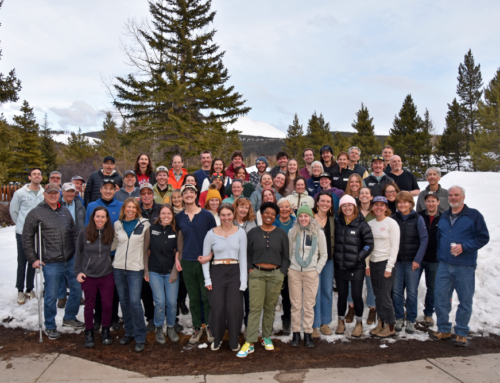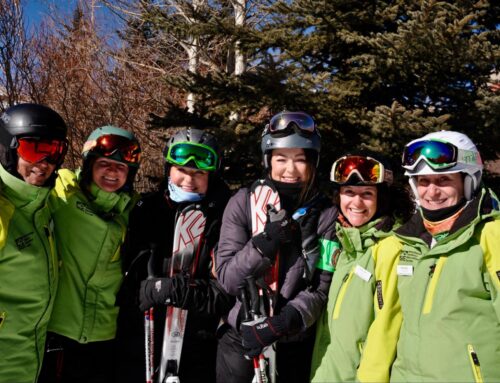
Margie and Joey geared up for an adaptive cycle adventure at Keystone.
A-Team, Dream Team, Dynamic Duo, any of these titles would be a great way to describe BOEC volunteers Margie Sinton and Joey Kraft. Year after year, they are integral to the summer BOEC Adaptive Cycling Program based out of the Keystone Adaptive Center. Margie and Joey work with groups such as Brain Injury Alliance of Colorado, local groups like Timberline Adult Day Program, and BOEC programs Adventures Within for those living with multiple sclerosis and Outdoor Active Retreat for those living with Parkinson’s disease. In addition, they dedicate time to providing access to day rentals for individuals who are in need of an adaptive cycle to explore local trails and enjoy the freedom of a bike ride in the mountains.
BOEC got the first small fleet of five Freedom Ryder handcycles in the late 90’s early 00’s which were used initially for Brain Injury Alliance of Colorado (BIA) programming. The early days were challenging, but as equipment improved so did the experience of our team and participants. Wilderness Director, Jaime Overmyer reflects on the beginning of the program, “The BOEC Adaptive Cycle Program started in the Summit County high school parking lot and also utilized the Breckenridge Ice Rink parking lot which offered the space we needed for these early bikes. Thankfully, Kelvin Clark from Colorado Springs based Angletech, a company specializing in adaptive cycles, became interested in what we were trying to do and would come up to all of the BIA camps and let us borrow new and different bikes as they were being developed. BOEC would not have the bike program we have today without Kelvin and his generous donation of time and expertise! Over the years, BOEC has purchased a number of adaptive cycles from Angletech, all with the latest technology in adaptive bikes that cater to the abilities of most of our participants.”

L to R:’ Emily Lawrence, Bob Bond, Jaime Overmyer, Mary Stoer-Wenger, Joe Kusumoto, and Jeff Pitts sitting on the adaptive cycle in 2007.
Joe Kusumoto, former long-time BOEC employee, continues to share the cycling program history,
“We moved bikes over to Keystone when we opened that office in 2006. There was more space and direct access to a bike path. Around this time we also explored adaptive downhill mountain biking. We visited Crested Butte’s Adaptive Sports Center and tried out their lift access mountain bike program. Later that summer we partnered with them and hosted a small event at Keystone. However, aside from a few individuals, mountain biking didn’t fit with the populations that BOEC most served. Also around this time the adaptive cycling equipment was focused on people with upper body strength and coordination (spinal cord injuries, leg amputees). So there were some creative adaptations to the bike to try to adjust them to the other populations BOEC served.”
Joe echoes Jaime’s statement “Getting connected with Kelvin and Angletech was the game changer.”
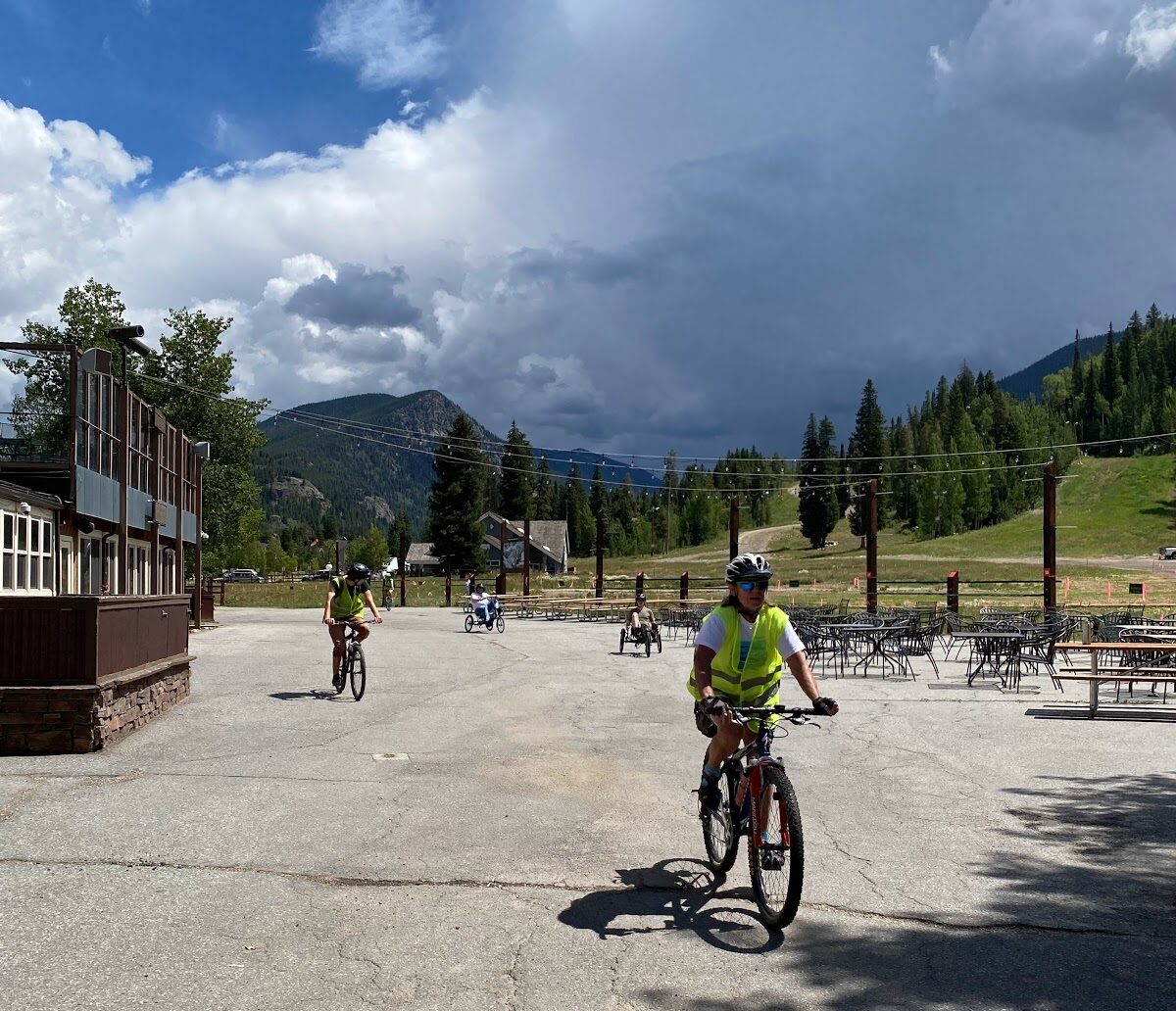
Margie leading a group of cyclists.
Since BOEC’s Cycling Program began operating out of the Keystone Adaptive Center, over 15 years ago, volunteers Margie and Joey have dedicated countless hours and endless energy to the success of this program. They appreciate the excellent location and trails which are conducive to group cycling adventures. As cycling enthusiasts themselves, the Adaptive Cycling Program is an excellent fit for Margie and Joey’s talents. While Margie focuses more on the participant experience and safety while riding, Joey, the mechanically inclined of the pair, focuses her efforts on keeping the cycles safe with continual maintenance and ensuring that adjustments to the cycles are made to fit each participant properly.
Margie and Joey are well versed in what it takes to run the program overall. Based on their knowledge of the equipment and participants, they ensure consistency in the care provided across the diverse range of cycles, which includes hand cycles, recumbent cycles, and e-cycles. Teamwork is also key to making this program run smoothly. One example is the work they did creating easy to understand explanations and directions for each cycle’s use, while the BOEC summer staff created QR codes, placed on each cycle, to make this information easily accessible. This increases knowledge and efficiency while ensuring the smooth functioning of the cycles year over year. With knowledge and experience, running the program has become easier and effectively caters to participant’s unique needs. Finally, of significant importance, are the experienced volunteers and staff who come to help with the program, forming relationships with participants and learning the intricacies of the various cycles and how they can best suit each participant who attends a BOEC Adaptive Cycling Program.

Joey and Margie helping out with the annual Tee It Up fundraiser.
As avid outdoor enthusiasts in both their professional and personal lives, Margie and Joey’s backgrounds contribute to their natural fit with the adaptive cycling program. Margie had previously spent years working with and managing Keystone Ski School and the now defunct Keystone rafting department, while Joey has also spent well over 20 years with Keystone Ski School and managing Christy Sports in Dillon and Frisco. In addition, both are seasoned instructors with the BOEC’s Adaptive Ski and Snowboard Program in the winter. In their spare time, Margie and Joey take full advantage of the mountains hiking, biking, kayaking, playing pickleball, camping, and skiing. They also enjoy scuba diving and have biked 500 miles across Iowa multiple times in the Annual Great Bicycle Ride Across Iowa.
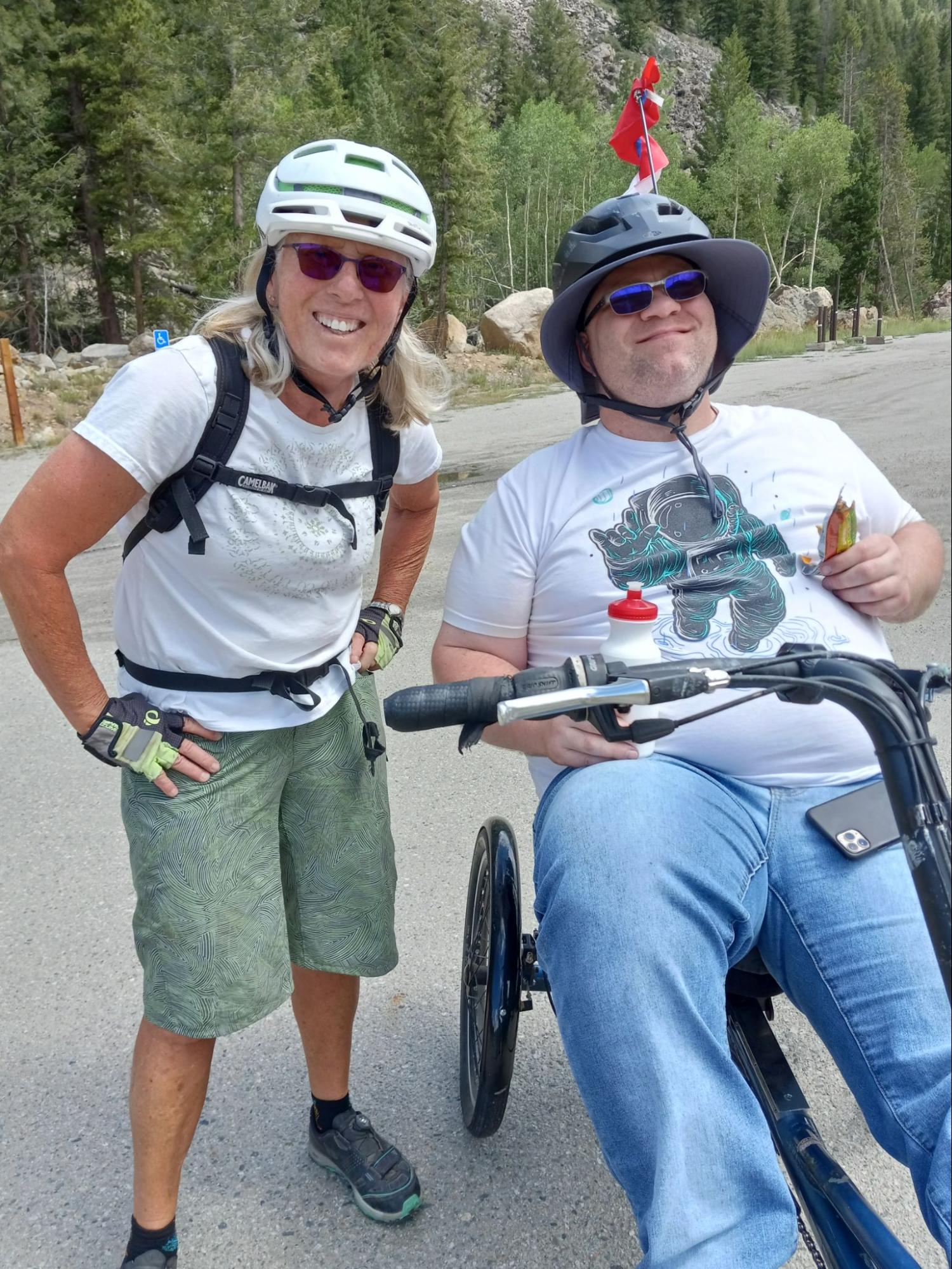
Joey with a Brain Injury Alliance participant in 2022.
These generous individuals are motivated to return to this summer program every year because they witness the participants achieving things they didn’t think were possible, resulting in smiles, joy, and increased confidence. This newfound confidence extends beyond cycling, empowering participants to embrace new experiences in the future. They appreciate being part of a memorable experience that brings together friends and family, regardless of their abilities. Margie and Joey not only teach participants how to ride adaptive cycles safely, but also learn valuable lessons themselves, such as perseverance and the limitless possibilities that come with adaptability. Adaptive cycling minimizes challenging factors like balance, making it an accessible and approachable experience.
Margie and Joey affectionately share stories of participants like Meredith, who has gone from riding in a side-by-side cycle with music playing and lots of careful coaching, to ten years later, riding her own bike. The adaptive cycling helped her grow and adjust to small changes until she had the focus and confidence to ride on her own. Bill is another long time participant who formed a relationship with BOEC and finds comfort in the familiarity with the cycling program and with the staff. For other participants, like a woman who became a paraplegic from an accident falling off of her horse, the adaptive cycling program has been a way to bring friends together. This individual found the BOEC Cycling Program as a way to reassess the possibilities available to her and try new activities she didn’t know were options. This was a healing experience that helped form a stronger bond between her and the friend she arrived with, bridging the gap of activities they could perform together and encouraged both positivity and possibilities.

Joey and a Brain Injury Alliance group take a break on a ride.
With all of the rewarding experiences come occasional challenges. The biggest challenges Margie and Joey face are the maintenance and range of adjustments that need to be made in the fleet of cycles depending upon each participant. Set up and fitting has gotten easier due to the improvements made to new equipment. However, with less use than other programming equipment, regular maintenance is performed less consistently and adjustments can be made incorrectly by inexperienced individuals. Fortunately, Angletech is still a BOEC partner and continues to help with parts replacements, maintenance and training in the care of the growing BOEC fleet of adaptive cycling equipment.
Margie, who works with the BOEC Adaptive Ski and Snowboard Program all winter, explains her thoughts on the main differences between summer versus winter programs. Participants can choose from a broad range of activities in summer from paddling to ropes courses, zipline, cycling, and so much more. In the winter, programming is focused mainly on adaptive skiing and snowboarding with other options of snowshoeing and nordic skiing. However, the goals remain the same between seasons, having fun and safely learning, enjoying the outdoor experience with “you can do it!” encouragement.
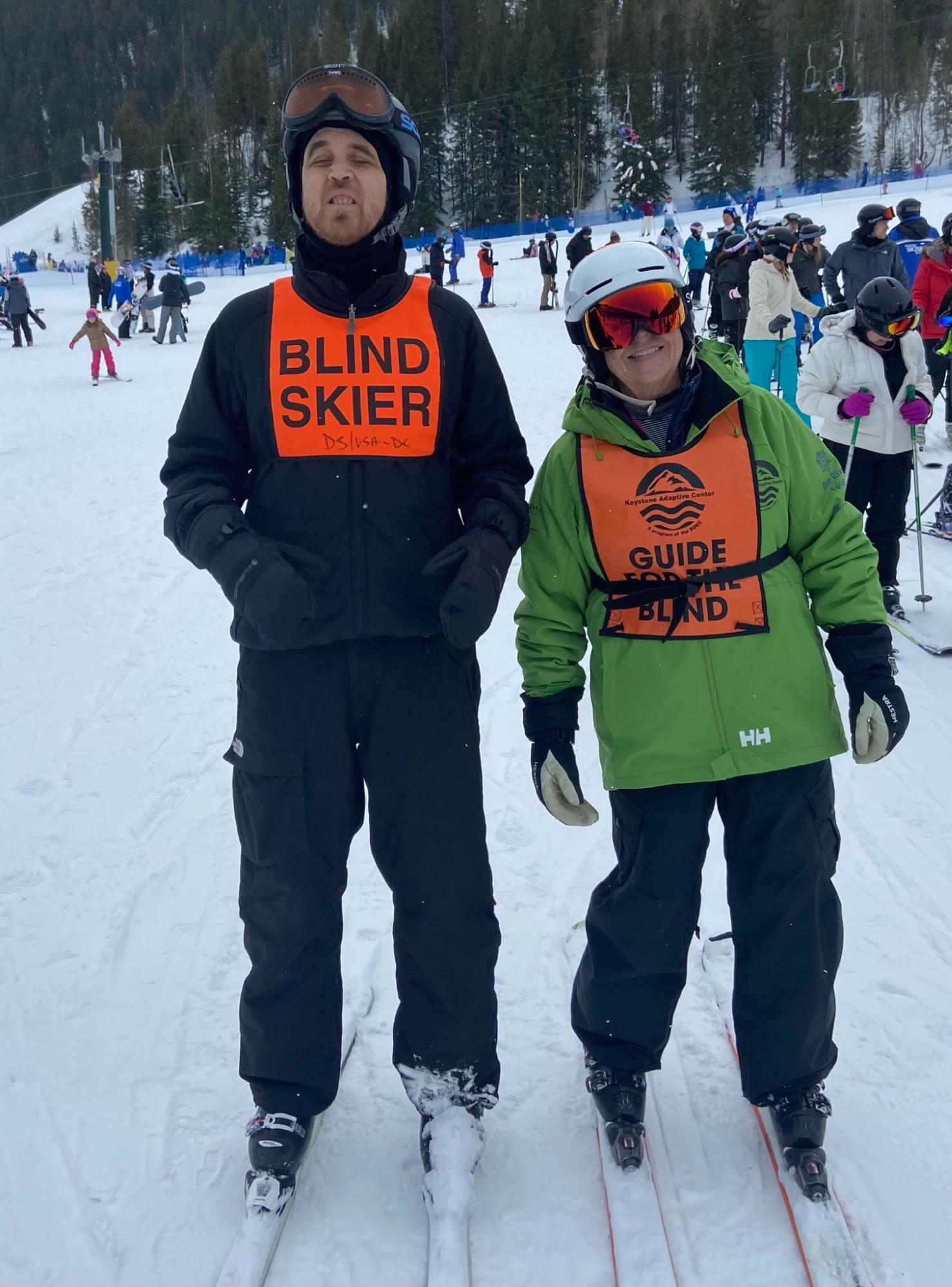
Margie instructing John Hermes at Keystone last winter.
As with most things, change is constant and the Adaptive Cycling Program is no different. Many of the new innovations in the cycling industry are making riding an adaptive cycle easier and increasing the possibilities of who can enjoy cycling. E-bikes have reached the adaptive cycling world and have created increased accessibility. There are also challenges that come with this new invention. Safety concerns and the complexity of operating an e-bike are complicating factors that can limit who and how much these bikes can be used but, of course, adapting is key, and safely utilizing new equipment is what we do to ensure that everyone has an enjoyable time outdoors.
We are so grateful to Margie and Joey for all of their hard work over the years supporting BOEC’s Adaptive Cycling Program and look forward to the many cycling days they will lead in the future!

